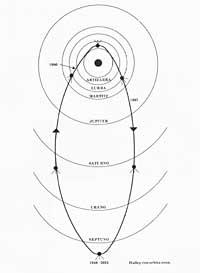Nemesis or looking for a friend for the sun
1986/04/01 Arregi Bengoa, Jesus Iturria: Elhuyar aldizkaria
What Voyager II shows us almost daily that we still do not know the solar system well, is the information that commands us on the outer planets. However, we already knew that, but many did not expect the components of the Solar System not to be known.
In the second quarter of a century, the debate was quite intense when the tenth planet was post-plutonic and was not. The need for this planet was raised in the light of some anomalies observed in the orbit of other planets and comet Halley. However, the results of observations on the orbit calculated between 1930 and 1945 were negative, so the hypothesis was ruled out.



Later, the list of components of the Solar System was extended by millions of comets in the cloud that Jaan Oort had planned to explain the origin of comets. As is known, this cloud would be one or two years of light from the Sun and comets would come from it, after having changed the orbit for some disturbance it has suffered. This hypothesis was already mentioned in the previous number when speaking of comet Halley. On this occasion we will give you a more concrete form, limiting the origin of the disturbance and commenting at the same time the existence of another possible component of the Solar System.
This protagonist, although it may surprise, would be another star; a star that, together with the Sun, would form the binary system and is known as Nemesis. But let's see the reasons that have given rise to this hypothesis.
History began at the end of the last decade with measurements made by Walter and Louis Álvarez, Frank Asaro and Hellen Michell on the distribution of iridium on the terrestrial surface. As a result of these measurements, the scientists cited had the opportunity to affirm that, sometimes, there were strata with a very high concentration of iridium, which could not be their terrestrial origin.
They could limit the age of some of these strata. One was 65 million years old. The data that allowed to relate the anomalous abundance of iridium with another phenomenon that paleontology had not clarified was the disappearance of 70% of tyrannosaurs and other living beings. What can be the relationship between such diverse phenomena?
This is the idea. As mentioned above, the origin of the percentage of iridium of the strata cannot be found on Earth. This being so, we must recognize that in times when these special strata appear, the Earth precipitated as a consequence of collision with other objects. These shocks caused various types of dust and remains, so they remained in the atmosphere for many years before they landed again, while the Earth became totally obscured. They avoided reactions of photosynthesis, causing the death of many plants and animals. This effect is the same that has appeared in recent years when analyzing the consequences of a nuclear war and is called "nuclear winter."
This hypothesis created by the aforementioned scientists is, undoubtedly, coherent. But if there were no evidence in his favor, it would not be easy to accept. Let's see below theoretical tracks. After planting the problem as we have seen before, Walter Alvarez, Richard A. Muller, Mark Davis and Piet Hut tried to locate the craters that could form the aforementioned collisions.
Among those analyzed, some presented two peculiarities: on the one hand they were very old and, on the other, they were too big to be created by volcanoes. Therefore, these craters were considered as a consequence of the shocks mentioned by the theory.
But we still have a very important problem in the need to clarify, how or with what body did the Earth crash occur? How can the periodic repetition of the layers with a high percentage of iridium be explained? To give an explanation, we cannot think of shocks with asteroids or meteorites, which occur by chance and never periodically. Where to find that periodic phenomenon that requires our theory in the Solar System?. Answer R. A. A. Muller and W. Alvarez's research on stars similar to the Sun gave rise.
According to the observations of these scientists, many stars similar to the Sun, perhaps more than half, appear in binary systems, that is, in systems of two stars that move around each other. Therefore, it is not a nonsense that the Sun also thinks of a friendly star that we cannot see so far. If we accept this possibility, for collisions the natural origin is imposed: at a specific time when the star was moving in its orbit, it would pass through the proximity of the cloud of Oort formed by comets and its gravity field would divert the orbits of thousands of comets into the interior of the Solar System. Norm could be the shock of some of these comets against Earth, producing all the consequences described above.
This is, in general, the story of this new friend of the Sun, called Nemesis. According to the periodicity of the layers that present iridium richness, Nemesis would fulfill a tour every 28 million years approximately. According to geological studies, the last time it passed near the clouds of Oort 14 million years ago, it will create a similar catastrophe within another 14 million years, covering the sky with dust and disappearing many species of life.

Gai honi buruzko eduki gehiago
Elhuyarrek garatutako teknologia





